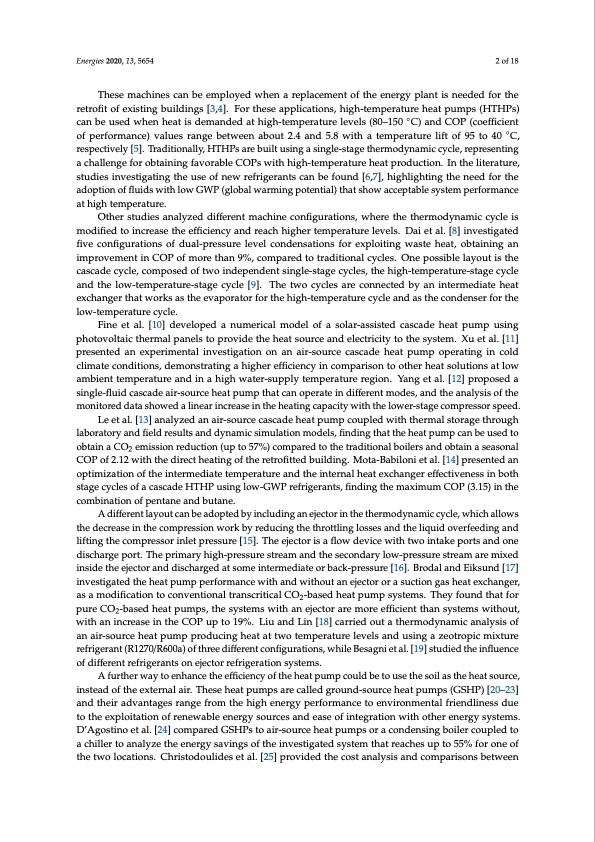
PDF Publication Title:
Text from PDF Page: 002
Energies 2020, 13, 5654 2 of 18 These machines can be employed when a replacement of the energy plant is needed for the retrofit of existing buildings [3,4]. For these applications, high-temperature heat pumps (HTHPs) can be used when heat is demanded at high-temperature levels (80–150 ◦C) and COP (coefficient of performance) values range between about 2.4 and 5.8 with a temperature lift of 95 to 40 ◦C, respectively [5]. Traditionally, HTHPs are built using a single-stage thermodynamic cycle, representing a challenge for obtaining favorable COPs with high-temperature heat production. In the literature, studies investigating the use of new refrigerants can be found [6,7], highlighting the need for the adoption of fluids with low GWP (global warming potential) that show acceptable system performance at high temperature. Other studies analyzed different machine configurations, where the thermodynamic cycle is modified to increase the efficiency and reach higher temperature levels. Dai et al. [8] investigated five configurations of dual-pressure level condensations for exploiting waste heat, obtaining an improvement in COP of more than 9%, compared to traditional cycles. One possible layout is the cascade cycle, composed of two independent single-stage cycles, the high-temperature-stage cycle and the low-temperature-stage cycle [9]. The two cycles are connected by an intermediate heat exchanger that works as the evaporator for the high-temperature cycle and as the condenser for the low-temperature cycle. Fine et al. [10] developed a numerical model of a solar-assisted cascade heat pump using photovoltaic thermal panels to provide the heat source and electricity to the system. Xu et al. [11] presented an experimental investigation on an air-source cascade heat pump operating in cold climate conditions, demonstrating a higher efficiency in comparison to other heat solutions at low ambient temperature and in a high water-supply temperature region. Yang et al. [12] proposed a single-fluid cascade air-source heat pump that can operate in different modes, and the analysis of the monitored data showed a linear increase in the heating capacity with the lower-stage compressor speed. Le et al. [13] analyzed an air-source cascade heat pump coupled with thermal storage through laboratory and field results and dynamic simulation models, finding that the heat pump can be used to obtain a CO2 emission reduction (up to 57%) compared to the traditional boilers and obtain a seasonal COP of 2.12 with the direct heating of the retrofitted building. Mota-Babiloni et al. [14] presented an optimization of the intermediate temperature and the internal heat exchanger effectiveness in both stage cycles of a cascade HTHP using low-GWP refrigerants, finding the maximum COP (3.15) in the combination of pentane and butane. A different layout can be adopted by including an ejector in the thermodynamic cycle, which allows the decrease in the compression work by reducing the throttling losses and the liquid overfeeding and lifting the compressor inlet pressure [15]. The ejector is a flow device with two intake ports and one discharge port. The primary high-pressure stream and the secondary low-pressure stream are mixed inside the ejector and discharged at some intermediate or back-pressure [16]. Brodal and Eiksund [17] investigated the heat pump performance with and without an ejector or a suction gas heat exchanger, as a modification to conventional transcritical CO2-based heat pump systems. They found that for pure CO2-based heat pumps, the systems with an ejector are more efficient than systems without, with an increase in the COP up to 19%. Liu and Lin [18] carried out a thermodynamic analysis of an air-source heat pump producing heat at two temperature levels and using a zeotropic mixture refrigerant (R1270/R600a) of three different configurations, while Besagni et al. [19] studied the influence of different refrigerants on ejector refrigeration systems. A further way to enhance the efficiency of the heat pump could be to use the soil as the heat source, instead of the external air. These heat pumps are called ground-source heat pumps (GSHP) [20–23] and their advantages range from the high energy performance to environmental friendliness due to the exploitation of renewable energy sources and ease of integration with other energy systems. D’Agostino et al. [24] compared GSHPs to air-source heat pumps or a condensing boiler coupled to a chiller to analyze the energy savings of the investigated system that reaches up to 55% for one of the two locations. Christodoulides et al. [25] provided the cost analysis and comparisons betweenPDF Image | Novel Ground-Source Heat Pump with R744

PDF Search Title:
Novel Ground-Source Heat Pump with R744Original File Name Searched:
energies-13-05654.pdfDIY PDF Search: Google It | Yahoo | Bing
CO2 Organic Rankine Cycle Experimenter Platform The supercritical CO2 phase change system is both a heat pump and organic rankine cycle which can be used for those purposes and as a supercritical extractor for advanced subcritical and supercritical extraction technology. Uses include producing nanoparticles, precious metal CO2 extraction, lithium battery recycling, and other applications... More Info
Heat Pumps CO2 ORC Heat Pump System Platform More Info
| CONTACT TEL: 608-238-6001 Email: greg@infinityturbine.com | RSS | AMP |